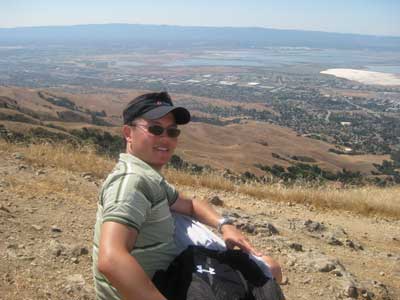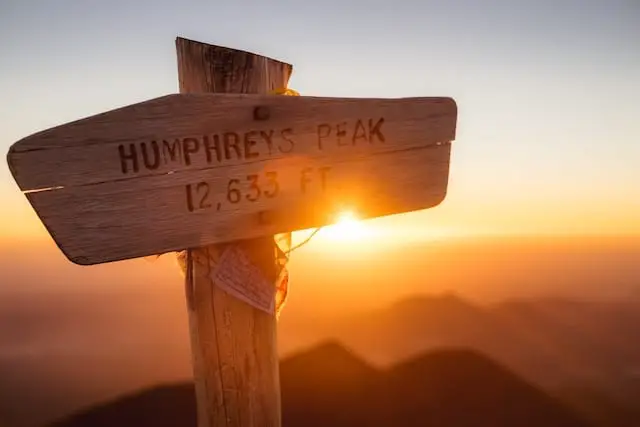
Humphreys Peak is the highest natural point in all of Arizona. Sitting at a lofty 12,633 feet, this giant amongst giants attracts large numbers of people all year round.
When to hike Humphreys Peak? You should hike Humphreys Peak in September. The large summer crowds will be gone and the temperature will be bearable.
To learn more about the weather and other important information about climbing Humphreys Peak, read on.
Humphreys Peak Weather
Spring weather
Springtime at Humphreys Peak is characterized by sun, snow, and chilly temperatures. You’d think near-constant sunshine would warm things up and prevent some of the snowfall, but the extreme elevation at Humphrey’s Peak negates the heat from the sun.
Night temperatures up on the mountain are usually below freezing, so you’ll want to be careful about hiking later in the day.
Summer weather
Summer on Humphreys peak is wonderful pretty good weather-wise. Temperatures at the top of the mountain usually sit at about 50 degrees Fahrenheit, and they approach 70 closer to the base of the mountain.
Fall weather
Early fall is the optimal time to go to Humphreys Peak. You should aim for September in particular, as it still retains some of summer’s decent temperatures while providing the multi-colored beauty that comes at summer’s end.
Winter weather
Climbing Humphreys Peak is certainly possible in winter, but the cold temperatures and excess of snow will make it a difficult climb. You may need even need to bring hiking poles and crampons to avoid slipping in the snow.
If at all possible, try to time your climb for one of the nicer seasons instead.
Which Trail Up Humphreys Peak is Best?
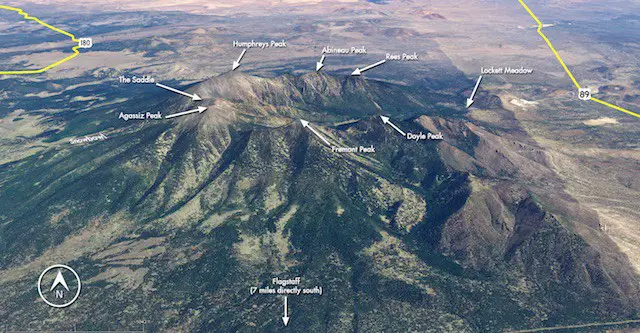
There are a few paths up to Humphreys Peak, but there’s one primary trail that most people use.
This trail is called the Humphreys Peak Trail. It begins at the Arizona Snowbowl, where you’ll start the hike by walking along one of the ski slopes. After a short distance, the trail enters a conifer forest, which will lead you to the boundary of the Kachina Peaks Wilderness.
You’ll walk past the sign marking the entrance to the wilderness and begin a series of steep switchbacks. This relatively difficult portion of the hike goes on for a few miles, until you eventually reach the edge of a valley.
This article is owned by Recapture Nature and was first published on August 31, 2019
Once you reach the valley, you’ll be at about 11,200 feet. This change in elevation is marked by the change in plant growth. Tall conifers give way to smaller trees and brush. The trail will begin to steepening sharply at this point, and the risk of altitude sickness will be greatest during this portion of the climb.
After some hard climbing, you’ll the saddle nestled between Humphreys Peak and Agassiz Peak. From here, it’s a short 1-mile stretch to the top of Humphreys Peak.
How Hard is the Hike?
The 10.2 mile hike up Humphreys Peak is pretty difficult.
Making your way to the top from the Arizona Snowbowl starting point requires a climb of more than 3,000 feet of elevation. Making your way up that kind of elevation change will be exceptionally hard for anyone who doesn’t regularly climb several thousand feet in a single day.
As if that weren’t enough, the hike is made even harder by the thinner atmosphere near the top of the mountain. There is less oxygen at the top of the peak than there is at the bottom, so hikers who aren’t accustomed to thin atmosphere will find themselves getting tired very quickly. Some people even suffer from altitude sickness on their way up, so be wary about that.
The terrain also adds to the difficulty of the hike. Much of the trail is covered with loose rocks and branching roots. If you aren’t careful, it can be quite easy to lose your footing.
How Much Preparation Do I Need?
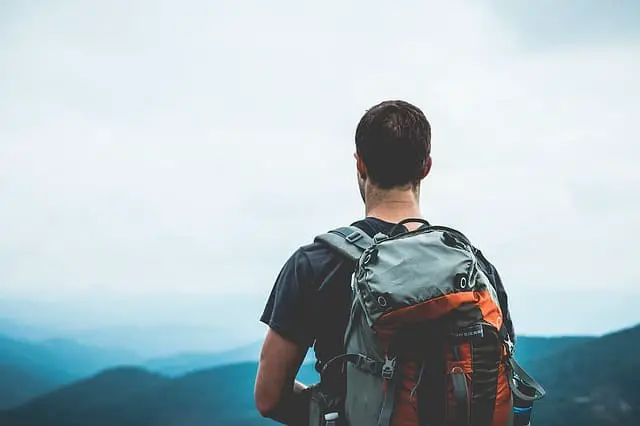
One of the nice things about the hike up Humphreys Peak is that it doesn’t require much preparation. Many mountains over 10,000 feet require ice climbing gear, camping gear, and a considerable amount of mountaineering expertise to reach the summit.
You don’t need that stuff to get to the top of Humphreys Peak. There are no glaciers standing between you and the top of this mountain. And although the hike is a longer one, you can easily make it there and back in a day.
The only things you’ll really need to be prepared for Humphreys Peak are decent physical fitness and a backpack with ample amounts of food and water. I also advise hiking this trail in a group of people, as you’ll be able to help each other if anyone gets sick or injured. This isn’t a requirement though ‒ just make sure to be extra careful if you’re hiking solo.
You should also be prepared for the possibility of altitude sickness. While this doesn’t involve bringing anything extra, you should know what the symptoms are and how to handle it if it does occur.
This article is owned by Recapture Nature and was first published on August 31, 2019
Altitude sickness symptoms
If you start to experience any of the following symptoms while climbing the mountain, you may be suffering from altitude sickness.
- Headaches
- Nausea
- Lethargy
- Shortness of breath
- Unable to exert yourself
- Loss of appetite
- Sleepiness
Treating altitude sickness

Altitude sickness is caused by a lack of oxygen in the body. As you go higher up the mountain, the relative lack of oxygen in the air makes it difficult for your body to get the oxygen it needs.
The only cure for altitude sickness is to get some more oxygen in your body. There are two ways to do this while you’re near the top of Humphreys Peak: strap on an oxygen tank, or head back down to a lower altitude.
Because Humphreys Peak is a relatively easy hike for how high it is, most people don’t bother bringing oxygen tanks with them. You should be fine without one, even if you do start to feel the effects of altitude sickness. As long as you start heading down the mountain when you notice yourself becoming ill, everything should be fine.
If you do want to be fully prepared for the possibility of altitude sickness though, you can store a mini oxygen tank in your backpack.
One more thing: while not strictly related to preparing for the hike, I want to mention that you can bring your dogs along with you. They do need to be on a leash though, so make sure you have those before leaving your house or hotel.
Can I Go Camping at Humphreys Peak?
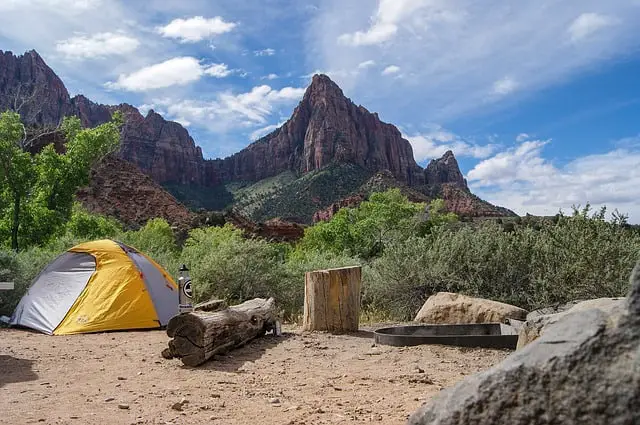
Humphreys Peak has some great camping spots. If you enjoy sleeping under the stars, a trip to Arizona’s highest mountain will not disappoint.
There are a few established campsites near the trail.
The first is at the Arizona Nordic Center, which is located near the trailhead. This camping spot has toilets, though it can get crowded during the peak summer months.
If you want a more scenic campground, I recommend checking out the Lockett Meadow Campground. It’s located in the Inner Basin, and it’s one of the most beautiful camping spots in all of Arizona.
This article is owned by Recapture Nature and was first published on August 31, 2019
How to Get to Humphreys Peak

The trail up Humphrey’s Peak starts at the Arizona Snowbowl. The main routes to the Snowbowl come from Flagstaff and the south rim of the Grand Canyon.
If you’re coming from Flagstaff:
- Make your way to Humphrey’s Street in the downtown area. Drive north for a little while.
- When you come to Highway 180, make a left onto the entranceway.
- Drive down Highway 180 for a few miles until you reach Snowbowl Road.
- Take Snowbowl Road until you come to the Arizona Snowbowl Ski Resort. You can park in the Hart Prairie parking lot.
- Take the path across the ski slope to reach the start of the Humphrey’s Peak trail.
If you’re coming from the south rim of the Grand Canyon:
- Take Highway 180 south.
- When you come to the junction of Highway 180 and Arizona Route 64, take a left to stay on Highway 180.
- When you come to Snowbowl Road, turn left and park in the Hart Prairie parking lot.
- Make your way across the ski slope to reach the start of the Humphrey’s Peak trail.

